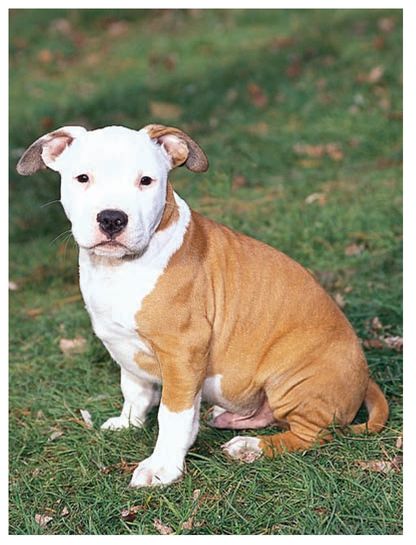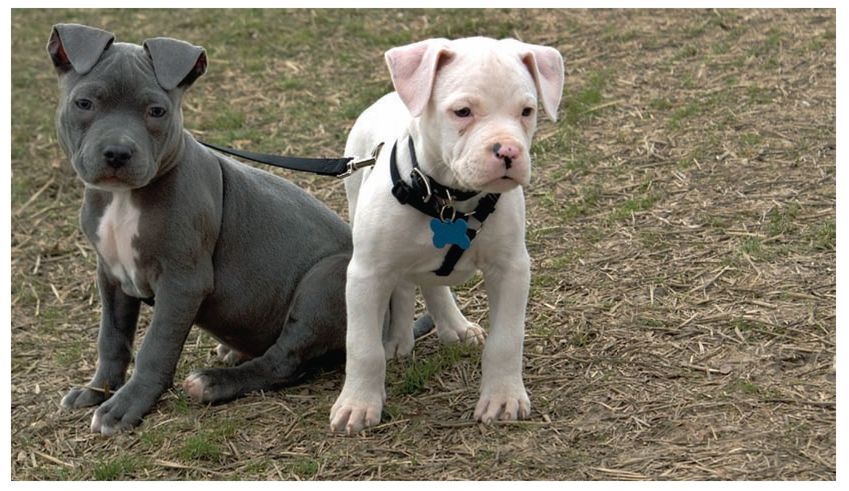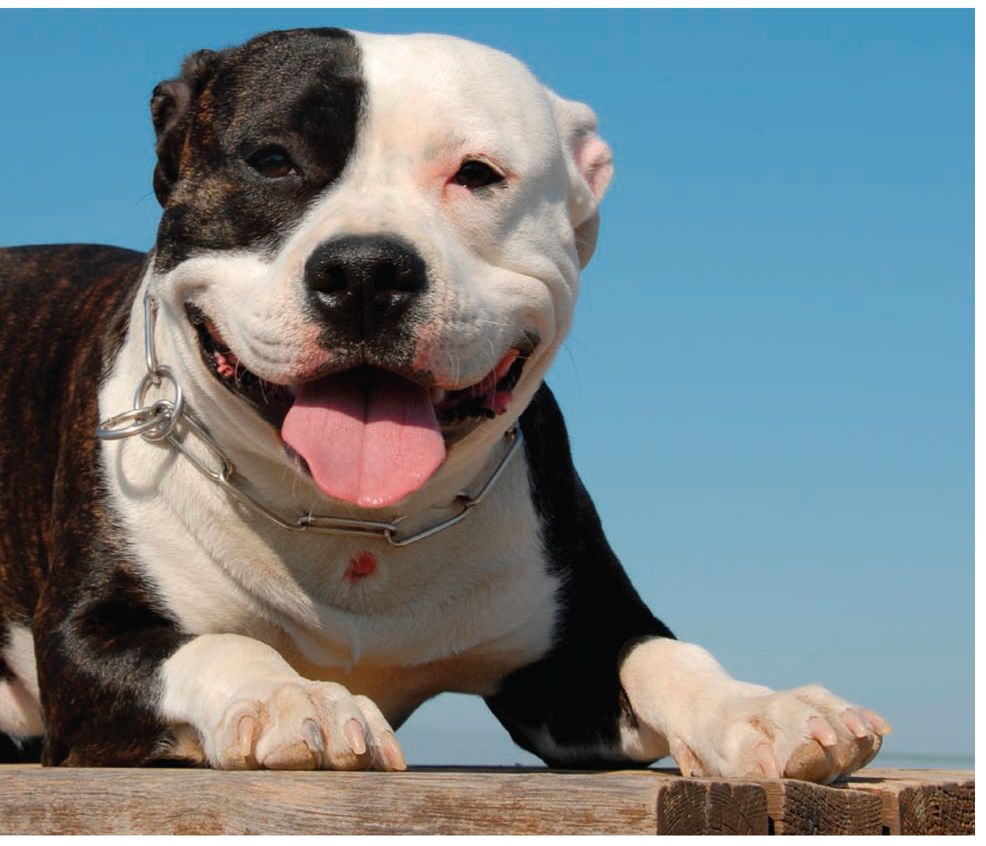CHAPTER 3
BREEDER AND THE BULLY
As rough and tumble as the American Pit Bull Terrier can be, nothing is cuter than a pit bull puppy. Their sweet faces and round little bodies inspire oohs and ahhs from all who see them. That wonderful endearing quality, however, can also distract you from taking the time and doing the legwork necessary to find a puppy who’s not only adorable, but healthy in body and temperament as well. The key to finding the best APBT puppy for you is to resist being charmed into a hasty decision and wait to find a responsible breeder. Then, have fun picking just the right puppy from a litter of those lovable faces.
You’re going to have your pit bull for 12 to 15 years, so the time you spend early on to locate a healthy, well-adjusted puppy from a reputable breeder will definitely pay off for you in the long run. Look for a dedicated and ethical breeder who values good health and stable personalities, and one who really cares what happens to the dog for the rest of his life spent with you.
Testosterone increases aggression. Most fatal dog attacks are carried out by intact (unneutered) males. With few exceptions, your life — and your dog’s life — will be much easier if you neuter him before sexual maturity. Even females can become more tractable when spayed, as some females tend to be more aggressive according to their estrus (heat) cycle.
Why is this so important? “This is a breed with a unique personality who needs to be bred correctly by someone with experience who really knows what he or she is doing,” says Valerie Piltz, vice president of the National American Pit Bull Terrier Association. “If not, you may wind up with a dog who’s overly aggressive, has a ton of health problems and doesn’t even look like an American Pit Bull Terrier.”
Be sure to avoid puppy mills and backyard breeders. Puppy mills are large-scale breeding operations that produce puppies in an assembly-line fashion without regard to health and socialization. Backyard breeders are typically well-meaning, regular pet owners who simply do not possess enough knowledge about their breed and breeding to produce healthy puppies.
The United Kennel Club provides a list of breeders in good standing with the organization. Visit their website for more information:
www.ukcdogs.com
EVALUATING BREEDERS
Once you have the names and numbers of breeders in your area, start contacting them to find out more about their breeding programs. But, before you pick up the phone, plan to ask the questions that will get you the information you need to know.
Prospective buyers interview breeders much the same way that a breeder should interview a buyer. Make a list of questions and record the answers so that you can compare them to the answers from other breeders whom you may interview later. The right questions are those that help you identify who has been in the breed a respectable number of years and who is actively showing their dogs. Ask in-depth questions regarding the genetic health of the parents, grandparents and great grandparents of any puppy you are considering. Ask what sort of genetic testing program the breeder adheres to.
Signs of a Good Breeder. When you visit a breeder, be on the lookout for:
• a clean, well-maintained facility
• no overwhelming odors
• overall impression of cleanliness
• socialized dogs and puppies
Choose a reputable breeder and you’ll get a well-socialized puppy.
A prospective buyer should look to see if a breeder actively shows his or her dogs. Showing indicates that the breeder is bringing out examples from his or her breeding program for the public to see. If there are any obvious problems, such as temperament or general conformation, they will be readily apparent. Also, the main reason to breed dogs is to improve the quality of the breed. If the breeder is not showing, then he or she is more likely breeding purely for the monetary aspect and may have less concern for the welfare and future of the breed.
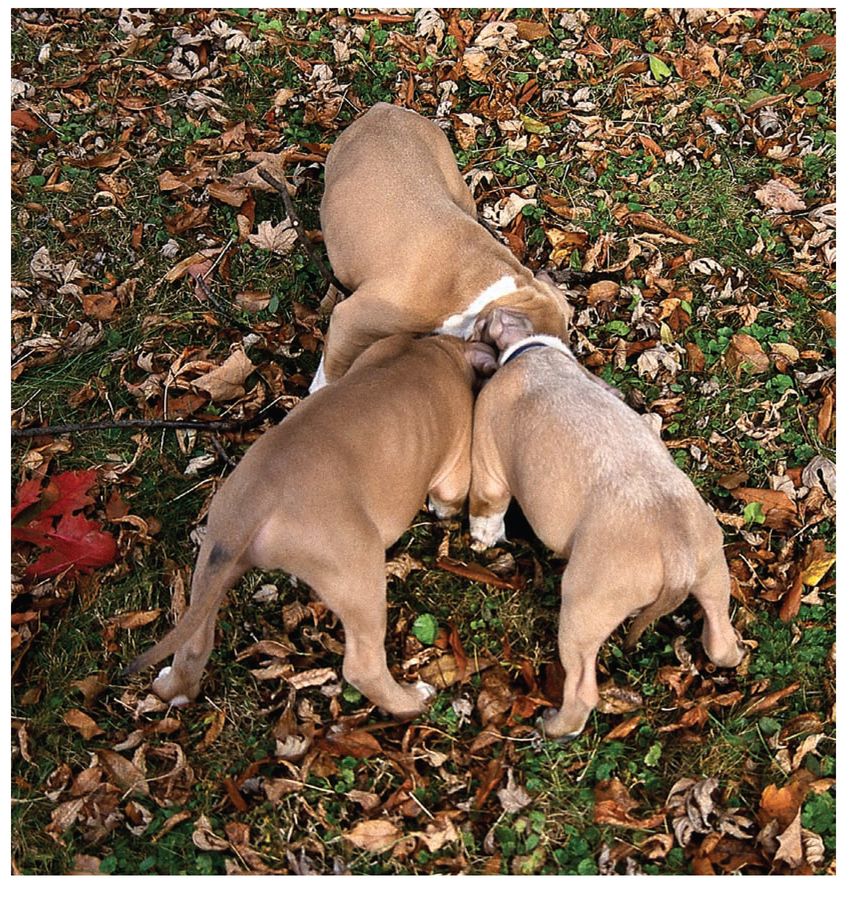
If a breeder advertises or tells you that their stock has an extra-large head size, is a rare color, weighs 80 pounds or more, is good for protection or provides stud service, run the other way. None of these claims describe what a purebred American Pit Bull Terrier is all about, and it’s usually an excuse to ask for more money. Take the time to learn about the breed before you contemplate buying or adopting one. — Valerie Piltz, vice president, the National American Pit Bull Terrier Association
Puppies learn to speak “dog” from their siblings, so be sure your breeder doesn’t let you bring home your puppy before at minimum 8 weeks of age.
Smart potential puppy buyers inquire about health and determine the breeder’s willingness to work with them in the future. The prospective buyer should see what kind of health guarantees the breeder gives. You should also find out if the breeder will be available for future consultation regarding the dog, and find out if the breeder will take the dog back if something unforeseen happens.
Healthy puppies have clear eyes, shiny coats, and are playful and friendly. An important factor in a puppy’s long-term health and good temperament is the age he goes to his permanent home, which should be between 8 and 12 weeks. This gives the pups plenty of time to develop immunity and bond with their mother.
Prospective buyers should ask plenty of questions, and in return, buyers should also be prepared to answer questions posed by a responsible breeder who wants to make sure their pit bull puppy is going to a good home. Be prepared for a battery of questions from the breeder regarding your purpose for wanting an American Pit Bull Terrier and whether or not you can properly care for one. Avoid buying from a breeder who does little or no screening. If breeders don’t ask questions, they are not concerned with where their pit bull puppies end up. In this case, the dogs’ best interests are probably not the breeder’s motive for breeding. You should find a breeder who is willing to answer any questions you have and is knowledgeable about the history of the breed, health issues and about the background of their own dogs. Learn about a breeder’s long-term commitment to the breed and to their puppies after they leave the kennel.
Look for a breeder who knows their purpose for producing a particular litter, one who is knowledgeable in the pedigrees of their dogs and of the breed itself, and has had the necessary health screenings performed on the parents. The breeder should also be asking you for references if they are interested in establishing a relationship with you in consideration for a puppy. If after one phone conversation with a breeder, the person is supplying you with an address in which to send a deposit, continue your search for a reputable breeder elsewhere.
CHOOSING THE RIGHT PUP
Once you have found a breeder you are comfortable with, your next step is to pick the right puppy for you. The good news is that if you have done your homework in finding a responsible breeder, you can count on this person to give you plenty of help in choosing the right pup for your personality and lifestyle. In fact, most good breeders will recommend a specific puppy to a buyer once they know what kind of dog the buyer wants.
After you have narrowed down the search and selected a reputable breeder, rely on the experience of the breeder to help you select the exact puppy. The selection of the puppy depends a lot on what purpose the pup is being purchased for. If the pup is being purchased as a show prospect, the breeder will offer their assessment of the pups who meet this criteria and be able to explain the strengths and faults of each pup.
Whether your pup is show- or pet-quality, a good, stable temperament is vital for a happy relationship. Generally, you want to avoid a timid puppy or one who is very dominant. Temperament is very important, and a reputable breeder should spend a lot of time with the pups and be able to offer an evaluation of each pup’s personality.
Questions to Expect Be prepared for the breeder to ask you some questions, too.
1.
Have you previously owned an American Pit Bull Terrier? The breeder is trying to gauge how familiar you are with the breed. If you have never owned one, illustrate your knowledge of APBTs by telling the breeder about your research.
2.
Do you have children? What are their ages? Some breeders are wary about selling a dog to families with younger children.
This isn’t a steadfast rule, and some breeders only insist on meeting the children to see how they handle puppies. It all depends on the breeder.
3.
How long have you wanted an American Pit Bull Terrier? This helps a breeder know if this purchase is an impulse buy, or a carefully thought-out decision. Buying on impulse is one of the biggest mistakes owners can make. Be patient.
Join Club APBT to get a complete list of questions a breeder should ask you. Click on “Downloads” at:
DogChannel.com/Club-APBT
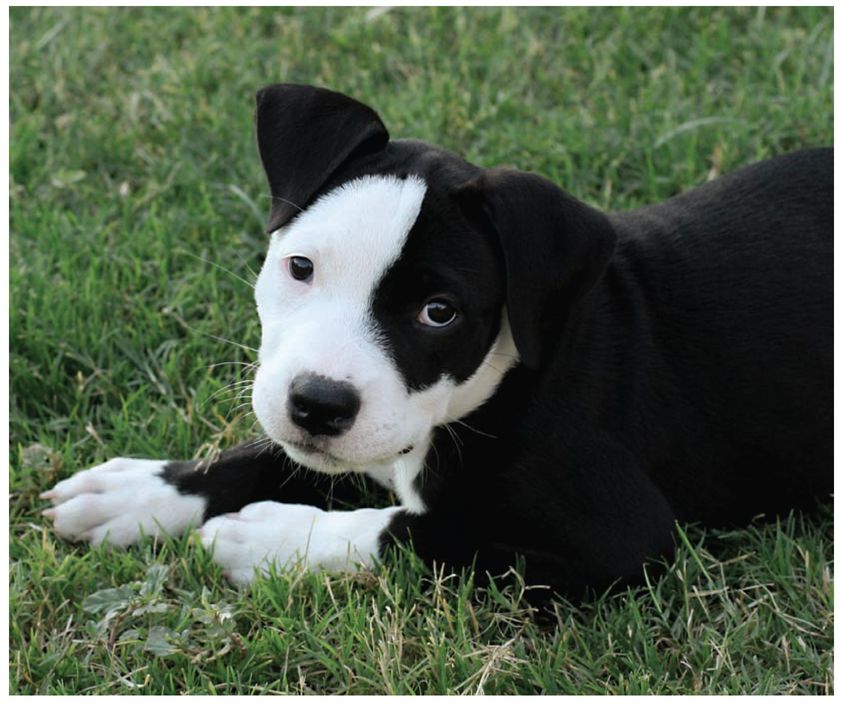
Reputable breeders should tell each buyer which puppy is appropriate for their home situation and personalities. They may not allow you to choose the puppy, although they will certainly take your preference into consideration.
Some breeders, on the other hand, believe it’s important for you to have a strong involvement in picking a puppy from the litter. Louis Colby, an American Pit Bull Terrier breeder in Newburyport, Mass., lets his puppy buyers make the decision on which pup to take home. “Not everyone is looking for the same things in a dog,” Colby says. “Some people want a quiet, laidback attitude. Others want an outgoing, active dog. When pups are old enough to go to their new homes at roughly 8 to 12 weeks of age, we prefer you make your own decision because no one can tell at this age which pup will make the most intelligent or affectionate dog. The color, sex and markings are obvious, but that is about all you can tell for sure at this age. Everything else being equal — size, health, etc. — we suggest picking the pup that you have a gut feeling for.”
Chemistry between buyer and puppy is important and should play a role in determining which pup goes to which home. When possible, make numerous visits, and in effect, let a puppy choose you. There will usually be one puppy who spends more time with a buyer and is more comfortable relaxing and sitting with or on a person.
WHY NOT RESCUE?
With the popularity of American Pit Bull Terriers, shelters and rescue groups across the country are often inundated with sweet, loving examples of the breed — from the tiniest puppies to senior dogs,
petite females to blocky males. Often, to get the pit bull of your dreams, it takes just a journey to the local shelter. Or perhaps you could find your ideal dog waiting patiently in the arms of a foster parent at a nearby rescue group. It just takes a bit of effort, patience and a willingness to find the right dog for your family — not just the cutest dog on the block.
The perks of owning an American Pit Bull Terrier are plentiful: companionship, unconditional love, true loyalty and laughter, just to name a few. So why choose the adoption option? Because you literally are saving a life!
Owners of adopted dogs swear they’re more grateful and loving than any dog they’ve owned before. It’s almost as if they knew what dire fate awaited them and are so thankful to you. Pit bulls, known for their people-pleasing personalities, seem to embody this mentality whole-heartedly when they’re rescued. And they want to give something back.
Another perk: Almost all adopted dogs come fully vetted, with proper medical treatment, vaccinations, medicine, as well as being spayed or neutered. Some are even licensed and microchipped.
Don’t disregard older dogs, thinking the only good pair-up is you and a puppy. Adult APBTs are more established behaviorally and personality-wise, helping to better mesh their characteristics with yours in this game of matchmaker. Puppies are always high in demand, so if you open your options to include adult dogs, you’ll have a better chance of adopting quickly. Plus, adult dogs are often housetrained, more calm, chew-proof and don’t need to be taken outside in the middle of the night. Five times. In the pouring rain.
The National American Pit Bull Terrier Association offers rescue support information (
www.napbta.com) or log onto
Petfinder.com (
www.petfinder.com). The site’s searchable database enables you to find a pit bull puppy in your area who needs a break in the form of a compassionate owner like you. More websites are listed in the Resources chapter on page 166.
CHECKING FOR APBT QUALITIES
Whether you are dealing with a breeder who wants to pick a pup for you or lets you make the decision alone, consider certain points when evaluating the pup that you may end up calling your own. The pup should be friendly and outgoing, not skittish in any way. He should be forgiving of correction. He shouldn’t be too terribly mouthy. The pup should readily follow you and be willing to snuggle in your lap and be turned onto his back easily without a problem.
Proper temperament is important. A pit bull puppy who has a dominant personality requires an experienced owner who will be firm during training. A puppy who is a little shy requires heavy socialization to build his confidence.
Evaluate each puppy’s temperament on your own, with the breeder’s permission. The temperament of the pups can be evaluated by spending some time watching them. If you can visit the pups and observe them first together with their littermates, then you can see how they interact with each other. You may be able to pinpoint which ones are the bullies and which ones are more submissive. In general, look for a puppy who is more interested in you than in his littermates. Then, take each pup individually to a new location away from the rest of the litter. Put the pup down on the ground, walk away and see how he reacts away from the security of his littermates. The pup may be afraid at first, but should gradually recover and start checking out the new surroundings
D-I-Y TEMPERAMENT TEST
Puppies come in a wide assortment of temperaments to suit just about everyone. If you are looking for a dog who is easily trainable and a good companion to your family, you most likely want a dog with a medium temperament.
Temperament testing can help you determine the type of disposition your potential puppy possesses. A pup with a medium, trainable temperament will have the following reactions to these various tests, best conducted when the pup is about 7 weeks.
Breeder Q&A Here are some questions you should ask a breeder and the preferred answers you want.
Q. How often do you have litters available?
A. The answer you want to hear is “occasionally” or “once or twice a year.” A breeder who doesn’t have litters all that often is probably more concerned with the quality of his puppies, rather than making money.
Q. What kinds of health problems have you had with your American Pit Bull Terriers? A. Beware of a breeder who says, “none.” Every breed has health issues. For APBTs, some health problems include chronic hip dysplasia, luxated patella and demodectic mange
Get a complete list of questions to ask an APBT breeder — and the correct answers — on Club APBT. Log onto
DogChannel.com/Club-APBT and click on “Downloads.”
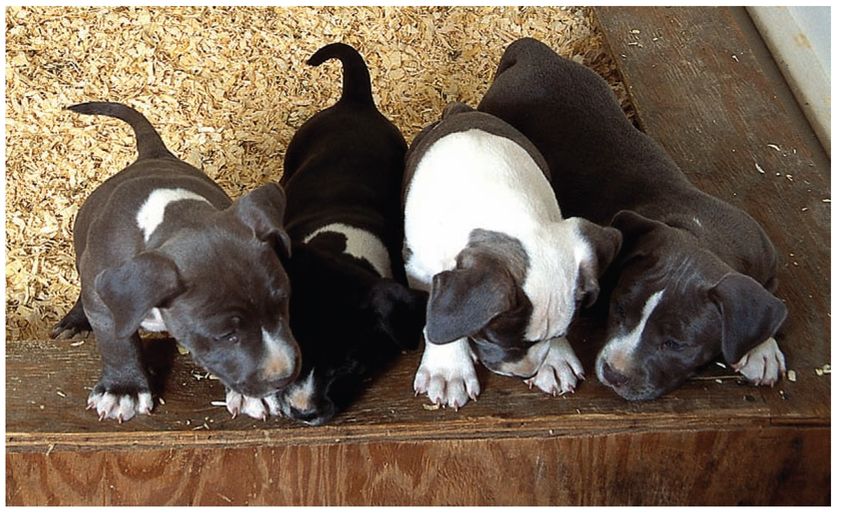
Step 1. To test a pit bull pup’s social attraction to humans and his confidence or shyness in approaching them, coax him toward you by kneeling down and clapping your hands gently. A puppy with a medium temperament will come readily, tail up or tail down.
Step 2. To test a pup’s eagerness to follow, walk away from him while he is watching you. The pup should readily follow you, tail up.
Step 3. To see how a pit bull pup handles restraint, kneel down and roll the pup gently on his back. Using a light but firm touch, hold him in this position with one hand for 30 seconds. The pup should settle down after some initial struggle and offer some or steady eye contact.
Step 4. To evaluate a pup’s level of social dominance, stand up, then crouch down beside the pup and stroke him from head to back. A pup with a medium temperament, neither too dominant nor too submissive, should cuddle up to you and lick your face, or squirm and lick your hands.
Step 5. An additional test of a pup’s dominance is to bend over, cradle him under his belly with your fingers interlaced and palms up, and elevate him just off the ground. Hold for 30 seconds. He should not struggle and should be relaxed, or he should struggle and then settle down and lick you.
Properly bred puppies come from parents who were selected based upon their genetic disease profile. Their mothers should have been vaccinated, free of all internal and external parasites, and properly nourished. For these reasons, a visit to the veterinarian who cared for the mother is recommended. The mother can pass on disease resistance to her puppies, which can last for 8 to 10 weeks.
Food intolerance is the inability of the dog to completely digest certain foods. Puppies who have done very well on their mother’s milk may not do well on cow’s milk. The result of this food intolerance may be loose bowels, passing gas and stomach pains. These are the only obvious symptoms of food intolerance, and that makes diagnosis difficult.
A HEALTHY PUPPY
To assess a puppy’s health, take a deliberate, thorough look at each part of his body. A healthy puppy has bright eyes, a healthy coat, a good appetite and firm stool.
Watch for a telltale link between physical and mental health. A healthy pit bull, as with any breed of puppy, will display a happier, more positive attitude than an unhealthy puppy. A pup’s belly should not be over extended or hard, as this may be a sign of worms. Also, if you are around the litter long enough to witness a bowel movement, the stool should be solid, and the pup should not show any signs of discomfort. Look into the pup’s eyes, too. They should be bright and full of life.
When purchasing a puppy, buyers hear from breeders that these dogs are just like any other puppy — times 10! They are very smart, calculating, stubborn and often have their own agendas. If prospective owners aren’t willing to spend a fair amount of time with a pit bull, then the breed is not for them. This bully breed wants to be with people more than other dogs and is quite like a 7-year-old boy in that he needs attention and consistent reinforcement for behavioral parameters. Once through adolescence, however, an American Pit Bull Terrier is the best friend, guardian and companion a person or family could have.
PUPPY PARTICULARS
Here are signs to look for when picking a puppy from a breeder. When in doubt, ask the breeder which puppy they think has the best personality/temperament to fit your lifestyle.
1. Look at the area where the pups spend most of their time. It is OK if they play outdoors part of the day, but they should sleep indoors at night so that the pups can interact with people and become accustomed to hearing ordinary household noises. This builds a solid foundation for a secure, well-socialized puppy. The puppy area should be clean, well lit, have fresh drinking water and interesting toys.
For a happy, healthy adult, you must begin training and socialization as a pup; that means finding a breeder who has already begun doing both before you take your puppy home.
2. Sure, you’re only buying one puppy, but make sure to see all of the puppies in the litter. By 5 weeks of age, healthy pups will begin playing with one another and should be lively and energetic. It’s OK if they’re asleep when you visit, but stay long enough to see them wake up. Once they’re up, they shouldn’t be lethargic or weak, as this may be a sign of illness.
3. Pups should be confident and eager to greet you. A pup who is shy or fearful and stays in the corner may be sick or insecure. Although some introverted pups come out of their shells later on, many do not. These dogs will always be fearful as adults and are not good choices for an active, noisy family with or without children, or for people who have never had a dog. These dogs frighten easily and will require a tremendous amount of training and socialization in order to live a happy life.
Choose a pup who is happy and eager to interact with you but reject the one who is either too shy or too bossy. These temperament types are a challenge to deal with, and require a lot of training to socialize. The perfect APBT puppy personality is somewhere between the two extremes.
4. If it’s feeding time during your visit, all pups should be eager to gobble up their food. Refusing to eat may signal illness.
5. The dog’s skin should be smooth, clean and shiny without any sores or bumps. Puppies should not be biting or scratching at themselves continuously, which could be a sign of fleas.
6. After 10 to 12 days, their eyes should be open and clear without any redness or discharge. Pups should not scratch at their eyes, this may cause an infection or signal irritation.
7. Vomiting or coughing more than once is not normal. The pup may be ill and should visit the veterinarian.
8. Visit long enough to see the pups eliminate. All stools should be firm without being watery or bloody. These are signs of illness or that a puppy has worms.
9. Pups should walk or run without limping.
10. A healthy puppy who eats enough should not be skinny. You should be able to slightly feel his ribs, but you should not be able to see the ribs.
BREEDER PAPERS
Everything today comes with an instruction manual. When you purchase an APBT, it’s no different. A reputable breeder should give you a registration application; a sales contract; a health guarantee; the dog’s complete health records; a three-, four- or five-generation pedigree; and some general information about behavior, care, conformation, health and training.
Signs of a Healthy Puppy Here are a few things you should look for when selecting a puppy from a litter.
1. NOSE: It should be slightly moist to the touch, but there shouldn’t be excessive discharge. The puppy should not be sneezing or sniffling persistently.
2. SKIN AND COAT: Your pit bull puppy’s coat should be soft and shiny, without flakes or excessive shedding. Watch out for patches of missing hair, redness, bumps or sores. The pup should have a pleasant smell. Check for parasites, such as fleas or ticks.
3. BEHAVIOR: A healthy APBT puppy may be sleepy, but he should not be lethargic. A healthy pup will be playful at times, not isolated in a corner. You should see occasional bursts of energy and interaction with littermates. When it’s mealtime, a healthy pup will take an interest in his food.
There are more signs to look for when picking out the perfect pit bull puppy for you. Download the list at
DogChannel.com/Club-APBTRegistration Application. This document from the United Kennel Club or the American Dog Breeders Association assigns your puppy a number and identifies the dog by listing his date of birth, the names of the parents and shows that he is registered as a purebred APBT. It doesn’t prove whether or not your dog is a show- or a pet-quality pit bull and doesn’t provide any health guarantee.
Sales Contract. Reputable breeders discuss the terms of the contract before asking you to sign it. This is a written understanding of your expectations about the puppy and shows that the breeder cares about the puppy’s welfare throughout his life. The contract can include such terms as requiring you to keep the dog indoors at night, spaying or neutering if the puppy is not going to be a show dog, providing routine veterinary care throughout the dog’s life, and assurance that you’ll feed your dog a healthy diet. Most responsible dog breeders will ask that you take your dog to obedience classes and earn a Canine Good Citizen title on him before 2 years of age. Many breeders also require new owners to have totally secure fencing and gates around their yard. American Pit Bull Terriers are incredible escape artists, and they will find a way out of the yard if there’s even the slightest opening.
Health Guarantee. This includes a letter from a veterinarian that the puppy has been examined and is healthy, and states that the breeder will replace the dog if the pup develops a genetic, life-threatening illness during his lifetime.
Health Records. Here’s everything you want to know about not only your puppy’s health, but the parents’, as well. It should include the dates the puppy was vaccinated, dewormed and examined by a veterinarian for signs of heart murmur, plus the parents’ test results for the presence or absence of hip and elbow dysplasia, heart problems and slipped patellas.
Pedigree. Breeders should give you a copy of the pit bull puppy’s three-, four- or five-generation pedigree. Many have photos of the dog’s ancestors they will proudly share with you.
Information. The best breeders pride themselves on handing over a notebook full of the latest information on APBT behavior, care, conformation, health and training. Be sure to read it because it will provide invaluable help while raising your dog.





